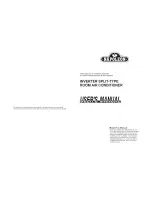
89
18. Troubleshooting
Guide
18.1 Refrigeration Cycle System
In order to diagnose malfunctions, make sure that there are no
electrical problems before inspecting the refrigeration cycle.
Such problems include insufficient insulation, problem with the
power source, malfunction of a compressor and a fan.
The normal outlet air temperature and pressure of the refrigeration
cycle depends on various conditions, the standard values for them
are shown in the table on the right.
Difference in the intake
and outlet
air temperatures
More than 8°C
(15 minutes after an
operation is started.)
at cooling mode.
Above 14°C
(15 minutes after an
operation is started.)
at heating mode.
Value of electric
current during operation
Normal
Inefficient compressor
Insufficient refrigerant
Excessive amount
of refrigerant
Dusty condenser
preventing heat radiation
•
Measuring the air temperature
difference
•
Measuring electric current
during operation
Less than 8°C at the cooling mode
Less than 14°C at the heating mode.
Higher than specified
Gas side
pressure
Clogged strainer or
capillary tube
•
Measuring gas side pressure
Cooling Mode
High
Lower than specified
Low
Low
Inefficient compressor
Insufficient refrigerant
Clogged strainer, capillary
tube or expansion valve
Heating Mode
Low
Low
High
Discharge air
Outlet air
temperature
Intake air
temperature
Normal Pressure and Outlet Air Temperature (Standard)
Gas Pressure
MPa
(kg/cm
2
G)
Outlet air
Temperature
(°C)
Cooling Mode
0.9 ~ 1.2 (9 ~ 12)
13 ~ 17
Heating Mode 2.0 ~ 2.7 (20 ~ 27)
32 ~ 42
*Condition: • Indoor fan speed = High
• Outdoor temperature 35°C at the cooling
mode and 7°C at the heating mode
• Compressor operates at rated frequency
















































